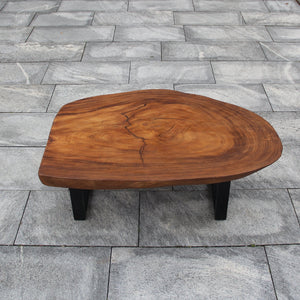Classification
Log tables are made of solid wood. Wood expands and shrinks with humidity. The key to long-term stability is not whether a crack is visible today, but whether the wood has been dried correctly and for a sufficient length of time. Cracks that occur during drying are a natural phenomenon and not a defect as long as the moisture content of the core has been fully equalized.
Why drying is more important than the current crack condition
Solid wood must release moisture slowly to relieve internal tensions. This can be achieved either through professional kiln drying (technical drying) or through prolonged air drying . If this step is abbreviated, the wood remains "in motion": cracks will continually open, panels will warp, and frames will become stressed.
Practical guidelines from our workshop:
-
Teak : for many panels, a shorter natural drying period (~2 months) is sufficient because the oil and pore structure of teak promotes drying.
-
Acacia (Suar) : takes significantly longer (up to ~3 years of air drying) until the cross-section is stress-free.
-
Chamber drying can accelerate these processes in a controlled manner – what is crucial is the achieved and balanced humidity level , not just the duration.
Bottom line: Correct, complete drying = stable structure. In this case, existing drying cracks are mostly cosmetic , not safety or usage issues.
Normal vs. critical: correctly classifying cracks
Normal
-
Hairline cracks / small radial openings on the cut edge of the tree disc.
-
Seasonal joint movement in the millimeter range .
-
No noticeable warping of the tabletop, table stands flat.
Critical
-
Continuous cracks that grow rapidly and “work” with climate fluctuations.
-
Significant warping/cupping of the tabletop; the base frame cannot be screwed together without tension.
-
Wood reacts strongly to changes in room → indication of residual moisture / incomplete drying .
Prevention in everyday life (if the wood is properly dried)
-
Aim for room air to be 40–55% RH (a small hygrometer is sufficient).
-
Keep a distance of at least 50 cm from radiators/fireplaces ; avoid direct sunlight.
-
Use coasters for hot/damp dishes; dry any moisture promptly.
-
Apply a thin layer of oil (hard wax/care oil) 1–2 times a year , always apply a thin layer and polish dry .
What to do if there are cracks?
When the board is completely dry and stable , cracks are primarily optical:
-
Clean/dust.
-
Fill cracks: suitable crack filler/wood putty/resin ; color match if necessary.
-
Fine sanding locally , then apply a thin layer of oil and polish dry.
Such filled cracks do not widen further when the wood is stress-free – they are a natural, permanent feature .
Warning signal: Wood not dried correctly
-
Cracks appear again after filling , panel warps, screws loosen → drying was insufficient .
-
In such cases, cosmetics won't help: It takes time/re-drying/constructive relaxation – often not economically viable. Therefore, clarify how the hair was dried when purchasing.
Purchase checklist (short & hard)
-
Ask about the drying method and duration for the specific board (e.g. chamber drying vs. air drying; often short for teak, considerably longer for acacia/suar).
-
Inquire about the target wood moisture content for the interior (usually around 8–12% indoors).
-
Plate thickness/cross-section : the more massive the plate, the longer it had to dry.
-
Check the stability of the frame (screwed without tension).
-
Visual inspection: Cracks appear “calm” (no fresh, bright fracture edges), edges stable, no sudden cracks.
Related Categories & Products
-
Category Tree trunk table → Tree trunk table & tree slice coffee table made of acacia – buy natural wood Switzerland
-
Category Coffee table wood (selection) → Root table for your living room: Round, Oval Square, buy in Switzerland
-
Examples:
Tree trunk table, real tree trunk wood, table made from a tree trunk
Showroom & Visit (Zurich Region)
Best time: 11:30–17:00 – please confirm appointment in advance.
Information on directions, entrance, parking & bell:

